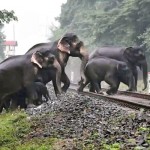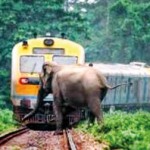News
Wildlife to try out Canadian radar gear at danger zone for elephants
View(s):By Kasun Warakapitiya
A multi-pronged plan will seek solutions to the human elephant conflict in areas where issues are widespread.
One such issue which contributes to elephant injuries and death are train collisions and the Departments of Wildlife, Forestry, Railways, university experts and environmentalorganisations are trying to reduce collisions.
Train collisions kill most elephants and cause damage to trains and tracks.
Railways General Manager, Dammika Jayasundara told the Sunday Times that elephants mostly roam in a 30 kilometre radius of the train tracks from Palugaswewa to Gal Oya, Gal Oya to Kantale and Gal Oya to Hingurakgoda .
As an immediate measure, the timetable was adjusted in areas frequented by elephants. As a result trains do not operate from 11 p.m. to 3 a.m., a window of four hours, in these areas.
Railways also used available track ballast to put between sleepers in areas frequented by elephants so the animals could move away when trains arrive. They are calling for fresh tenders to purchase more ballast.
Mr. Jayasundara said that on a request from the Railway, the Forest Department has started clearing shrub on either side of the track to increase the visibility for train drivers.
He added that there were long-term plans to discourage elephants from crossing the train track, including shifting water sources across the track to forested areas, and removing hilly areas on the sides of the track.
“We have identified some hilly areas on the sides of the track so if an elephant gets caught in the middle of the track it leads to a collision. We reduced the train speed between30 to 40 kilometres per hour,” he said.
The Department of Wildlife Conservation said it is coordinating with other stakeholders such as the Forest Department, railway, and Ministry of Science and Technology to finding solutions to the human elephant conflict as well as to reduce deaths of elephants from train collisions.
The Director General Ranjan Marasinghe told the Sunday Times the forest department was given money to clear brush.
He said enrichment in the wildlife protected areas will be carried out to keep the animals from venturing out.
Mr Marasinghe said he asked an environmental organisation to assist in getting a large animal detection system, developed and used in Canada.
He sought the support of the same organisation to set up a sensor system driven train track illumination project.
The Wildlife and Nature Protection Society (WNPS) has agreed to get the radar-based, large animal detection system (LADS), developed and used in Canada, as well as sensor based illumination system for two separate pilot projects tohelp train drivers detect animals ahead and improve their visibility.
LADS have been designed to monitor large animals on highways and warn motorists for as long as animals remain in the monitored area.
This system, powered by solar power, uses laser beams to detect elephants crossing designated railway tracks a kilometre away. When the beam is interrupted, it triggers warning lamps along the rail tracks. These lamps alert train drivers, prompting them to reduce speed.
WNPS has also taken charge of a train detection and area illumination project where sensors detect approaching trains and illuminate the tracks ahead for 2 km, improving visibility for train drivers.
The Forest Department cleared the shrub near the tracks extending from Gal Oya.
Forest Conservator General Nishantha Edirisinghe said that as the lands near train tracks extending from Gal Oya area belong to the department, on a request of the DWC and Railway, visibility near the track is being improved.
He said there is also a plan to create water sources such as ponds and tanks within their land as well as remove invasive plants and promote greenery for elephants to feed on.
A meeting was held at the Ministry of Science and Technology on Monday with the participation of officials from relevant institutions and departments under the Ministry of Environment and the Ministry of Transport. The discussion focused on integrating technology and adopting a scientific approach. A follow-up discussion on mitigating elephant-train collisions/human-elephant conflict also took place in Parliament on Tuesday.
During the meeting at the Ministry of Science and Technology, 17 suggestions to mitigate elephant–train collisions were discussed. Among the suggestions were projects that use seismic wave sensing, Infrared and beam sensor technology, thermal cameras, GPS and non-GPS collars, and a few other technologies.
According to the Secretary of the Ministry of Science and Technology, Y. L. Mohamed Navavi, the suggestions were evaluated, and further instructions were given.
It was decided that some suggestions need further research, while some need field trials. Some projects are suggested to be integrated with existing projects.
An elephant–train collision prevention system proposed by the University of Peradeniya was to be implemented immediately after reviewing ongoing field trials. Another project was suggested to be integrated with an existing Canadian project handled by the DWC.
The best way to say that you found the home of your dreams is by finding it on Hitad.lk. We have listings for apartments for sale or rent in Sri Lanka, no matter what locale you're looking for! Whether you live in Colombo, Galle, Kandy, Matara, Jaffna and more - we've got them all!




